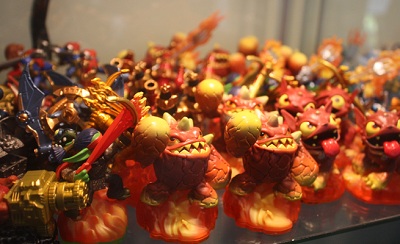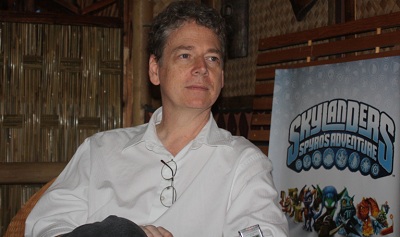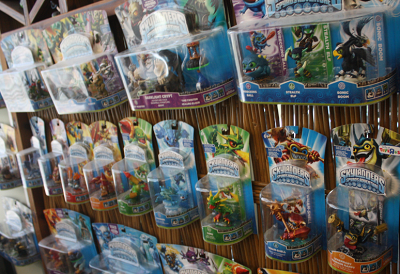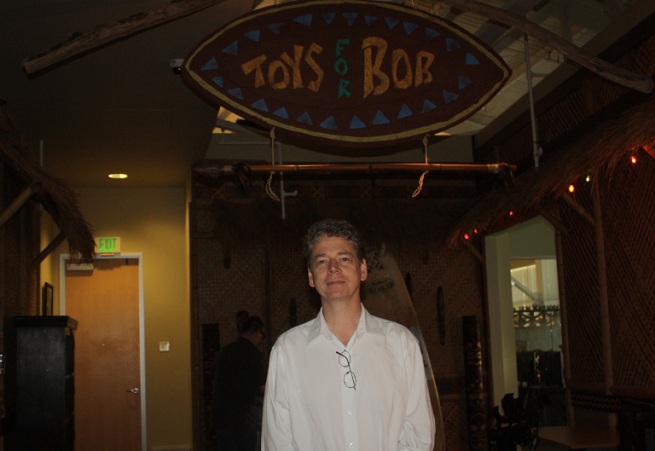Paul Reiche III is the president of Activision Blizzard’s Toys for Bob game studio. The company labored in obscurity for decades, but last year’s Skylanders: Spyro’s Adventure put Reiche’s team in the spotlight. The hybrid toy-game combination was the most successful new video game of 2011. It’s spurred the sales of 40 million Skylanders toys, and many of those are being used to activate characters in video games sold alongside the collectible figures. So far, Skylanders has been the top-selling game of the year for Activision.
Activision bought the studio in 2005, but it still runs as a separate entity in Novato, Calif. Now it’s working on Skylanders Giants, the sequel to the first Skylanders that’s coming out just a year after the last game. Here’s an edited transcript of our visit with Reiche on Tuesday at the company’s Tiki-style headquarters.
 GamesBeat: You’ve turned Activision into a very large toy company. [Laughs]
GamesBeat: You’ve turned Activision into a very large toy company. [Laughs]
Paul Reiche: Yeah, it’s amazing.
GamesBeat: It seems like that whole idea turned out to be very disruptive. How much of this do you think is great timing, or how much of it was your plan?
Reiche: Well, it’s a combination of those two. We were very intentional about what we tried to do, and we were pretty confident that the audience was going to like it. But a number of factors effectively magnified our success. There really wasn’t anything competing with us, both in the software and in the hardware realms. It was a slow time. Plus, it was a great idea, and Activision had RedOctane and the business that was built around Guitar Hero ready to support us. Luck is always a component of it, but you have to have everything else lined up. I feel fortunate, but we thought it was going to be pretty successful. I don’t think any of us believed it was going to be this successful.
GamesBeat: What sales numbers are the games and toys hitting?
Reiche: I’d have to double-check on what I’m allowed to say. I know that, toy-wise, we’re in excess of 40 million. I don’t know if I can say exactly where between 40 million and 50 million we are. Up until the day Black Ops II releases, we’ll be the number one Activision title this year. Then we’ll be the number two title this year. [Laughs] We always combine our toy revenue and our software revenue. We don’t distinguish that much. We saw a big pulse after Christmas, and then pulses when the toys would arrive, and we’d sell out. But it’s been a consistent seller.
 GamesBeat: Is this in a class by itself, or are a lot of digital game/toy combinations doing well now?
GamesBeat: Is this in a class by itself, or are a lot of digital game/toy combinations doing well now?
Reiche: I don’t really know if there are. I have friends who’ve bought the cars that play on your iPad, the Appmates, and they like the idea. But the execution isn’t complete enough to make it feel magical. We don’t have any competition that we’re aware of yet. I had thought that this year, someone who’d seen us a year ago, before we released, would catch up. It’s a pretty hard task.
GamesBeat: The timing for the technology was right. If you’d had the idea five or 10 years earlier, the technology would have been too expensive to do it.
Reiche: That’s correct. It was a confluence of the technology getting incorporated into a bunch of subway cards and security cards. As those numbers escalated into the tens of millions around the world, prices dropped down. So the core electronics cost, both for the reader inside the portal and for the tags inside the toys, reached a price that we could incorporate into a consumer product. It’s just getting better.
Initially, Skylanders went through a cycle where we almost released it, and then we delayed by a year. That delay made a huge difference. The cost on read/write technology dropped. Initially, we were just using read technology. We could identify the toy, but we couldn’t write back to it. We had this difficult pairing in beta.
Then [the cost] dropped down. And RedOctane is also able to save us a bunch of money. We’re watching a lot of other technology now as it drops down. We want to make these toys magical going forward. There’s a ton of stuff we can do with that if other technologies drop in price.
GamesBeat: And it’s 100 people or so now working on Skylanders?
Reiche: Yeah. We’re expanding into the rest of this floor. We’ll be the entire top floor of this hangar. We’re going to expand with about 20 more permanent people here for the next project we’re working on. We still continue to work with Vicarious Visions and Beenox up in Canada. We work with other studios on aspects of Skylanders.
GamesBeat: How long have you been working on Skylanders?
Reiche: We’d been working on it for three and a half years. Two and a half years on Spyro’s Adventure and one year for Giants.
GamesBeat: I remember that, when you pitched it, Activision said “Run with it!” and you were kind of surprised.
Reiche: We spent a year and a half getting to that point. Bobby Kotick [Activision Blizzard chief executive] believes that Activision has a great capability [to succeed] on large opportunities and can really hit those hard. What he wanted to do was make Skylanders bigger so Activision could hit it harder. And so he asked us bluntly, “If I give you guys another year, can you make this a lot better?” It was just so funny to me. That’s usually, 99 times out of 100, the other way around. You ask the publisher for another year. I’ve never heard of it before, where the very top executives say, “Go spend more time.”
They provided us with resources for that year. I’m not trying to unnecessarily promote Activision, but when I say that it takes an Activision to pull something like this off, I mean it. To make the game and get all the toys developed took many, many tens of millions of dollars. That’s not something that many software developers can do. It’s also not something that many toy developers can do. They’re obviously not comfortable in the software world. Activision sits at a unique crossroads, where there’s only two or three other studios I can think of that could pull it off.
 GamesBeat: Here’s a game that’s cross-platform and there’s toys in it. You think, “Wow, there’s great monetization possibilities here.” But that only works if you have a core value to the game that you can offer to the player, to the kids. How do you do some of that balancing where people understand that they’re going to have to buy the toys but get something out of it?
GamesBeat: Here’s a game that’s cross-platform and there’s toys in it. You think, “Wow, there’s great monetization possibilities here.” But that only works if you have a core value to the game that you can offer to the player, to the kids. How do you do some of that balancing where people understand that they’re going to have to buy the toys but get something out of it?
Reiche: While the business model does assume certain toy sales, the game has to be worth the money you pay for it if you don’t buy another toy. One of the things we did was to use that as a pillar. This is the first game where we composed concrete pillar statements and referred every decision back to them. One of them had to do with value, particularly compared to first-party games. That worked very well. Since we’d never done it before, and nobody had ever done it before, we had to set principles that we operated from. One of them was, “You don’t need more toys. But every one you buy gives you value.” What it required was that we make sure that each toy play experience was sufficiently different, not only in terms of the graphics and the effects but also in terms of how it played with other characters.
Also, the amount of time over which a character developed [in the game] was measured in excess of four hours, and hopefully more. We were looking at what the value of an $8 or $10 toy might be. We were really conservative. It turns out that people have much more than four hours, and that there’s value to the toys outside of the game. Kids are really enjoying them. So we said, “Let’s take a stab at guessing what the attach rate is going to be. Let’s make sure the game can be played with none, and that there’s a sweet spot at our attach rate.”
Then we continued to set milestones out to a ridiculous amount of toys and gave people continuous benefits all the way out there. It has to succeed in its initial starter-kit sets. And then no toy can rely on anything but itself to sell itself. Each toy has to have personality and value and shelf appeal. We’re asking people to do this new thing, to continue to spend money after they buy the game. In order to make that a reasonable request, we have to provide a lot of value.
 GamesBeat: This is why you worked so hard on designing the toys first, getting the characters right, and then finding a place for them in the game?
GamesBeat: This is why you worked so hard on designing the toys first, getting the characters right, and then finding a place for them in the game?
Reiche: That’s also why we make sure the gameplay duration is quite long. Skylanders and Skylanders 2 both are quite long for kids’ games. We needed to have a playground that was sufficiently large and expansive, and across a difficulty continuum, that it made sense to have eight or 10 toys in that world.
GamesBeat: Does it not work if you have 100 toys?
Reiche: It works for some people. We can monitor the graph of our players and the number of toys they’ve used. We don’t know who they are. But we can monitor that. There’s a pulse at eight, which is one per element, and then it decays down. Then we see a pulse at 32, which is really surprising. Some people are buying every toy. And then, at each multiple of 32, we saw peaks. What we’ve discovered is there’s a reasonable amount of the money we’re making from people who are buying a huge number of toys.
It’s an effect that’s well known in the toy-collecting world, but I had a hard time fathoming it until we did the math. We said to ourselves, “Wow. We need to support this group of people who are willing to spend such a large amount of money and time collecting those toys.” We couldn’t just say, “Well, our attach rate is six and therefore beyond that we’re not going to give you anything new.” We had to support that. That’s one of the reasons why we brought out the Series Two toys.
We wanted to make sure that there were options to buy toys that you may not have gotten the first year, and that if you wanted to buy a second version of a toy you liked, that there was some improvement. It was a really hard request to ask parents to buy the exact same toy twice. We needed to have some value there, so they would see that they not only got this cool new toy impression but that there’s a meaningful change in the game.
GamesBeat: How did you make the Giants game a better experience?
Reiche: One way is that we knew what we were doing the second time around. [Laughs] The story is more coherent. The last time, part of what we did was to tear apart all of our levels and resequence them. The story underwent these transformations. And it ended up as a fun story. But this time, we pretty much knew what we wanted to do from start to finish. There was much less starting and stopping. Alec Sokolow did most of the writing, or almost all of it, and we worked with Alec and Joel Cohen as consultants this time around, not as key writers. Having the narrative closer to the game allowed us to unify them more tightly. Also, taking over the other platforms, doing the 360 and the PS3 ourselves, allowed us to make the games more consistent across all platforms.
There was improved combat. That was a big deal. While the game isn’t entirely combat, at its core our guys are monster warriors. One of the things we did was to have the enemies react differently to giants compared to normal characters. There’s a meaningful change when you switch characters. The little guys will back away from you. Some of the enemies are much harder to deal with if you’re big, actually. There are cases where you’ll arrive at an enemy, and if you’re in giant form, all of a sudden you’ll realize you’re not maneuverable enough to deal with this guy. You’re going to have to switch to one of your normal Skylanders.
Our levels are longer this time around. There’s more playtime. We also added the difficulty levels. While that may seem trivial, it added a lot to our experience with the game. Once you start messing with difficulty, a lot of the detail in the characters starts to emerge. You have to start relying on the difference between distance attacks and short-range attacks. When your character takes some damage, you need to pull him off right away and get somebody else in.
 GamesBeat: You have 10 months to do this one. What’s it feel like to be on the Call of Duty cycle? [Laughs]
GamesBeat: You have 10 months to do this one. What’s it feel like to be on the Call of Duty cycle? [Laughs]
Reiche: The game worked out better than I thought it would. I know my staff, and they’re very talented. They like to sprint. But we had just sprinted for a year already. I had concerns. We really wanted to make sure that we delivered value when we asked people to spend money again. I have to credit my guys here. The moment we were done with Skylanders, we were running as hard as we could. We couldn’t overreach in that period of time, or we’d have a bunch of half-baked ideas. We tried to focus it down onto things that would reinforce the narrative of Giants.
One of the things we did that I think drove some people crazy, though, is that we didn’t stop adding new features until we shipped. We knew that there was a risk-reward equation involved. If we dialed down expectations too low, we wouldn’t deliver value beyond Skylanders. But we really risked introducing bugs at the end, so we required an expanded test staff to make sure we didn’t introduce anything bad. Fortunately, my guys know their engine, and they know what they can do. Things worked out well.
GamesBeat: And now you’re ready to do one every year?
Reiche: You know what? I would like us to do what Activision’s doing with Call of Duty and have two teams that leapfrog each other, so we have two years to deliver on innovation. Not only do you need to innovate in toys, but we’re going through a console transition now, and it’s not an obvious one. I don’t know what’s going to happen.
The whole cloud gaming thing is interesting. It seems like something that should work, to me. It’s not obvious yet, but if you imagine, for example, turning on your Samsung smart TV, and there’s a place for Skylanders on that screen. Just plug the portal in the side and play. Having a direct relationship with the consumer like that would be very powerful. But that’s a big risk. You now have platforms that are stronger. At minimum, the Wii U is stronger than the Wii by enough that we can approach the [existing console] platforms similarly. But then soon enough we’re going to have these more powerful platforms.
The question is, does our audience care? How important is toy innovation versus narrative versus high-tech graphics features? We know what you need to do to succeed in the first-person shooter market. But kids aren’t the same. They value things differently. Their parents value things differently, too. Making sure that we spend our time and energy innovating in the right space is a big challenge, and not an obvious one.
GamesBeat: The capability to buy the toy directly within the Kindle Fire tablet game is pretty interesting.
Reiche: It is. We talked about that for a long time. It’s an interesting experiment. In a way, we can’t make buying the toys too easy, or at least we run a risk. If you can snap your fingers and buy everything all at once, then that thrill of the chase is lost. They’re moderating that with the Kindle deal. It’s very interesting. There’s a cycle of toys that become available. I’m curious to see how that works out.
Some people have asked, “Well, now that this is successful, could you get rid of the toys and just make the game?” I have to shake my head and say, “Without toys there is no game.” This is that connection.
The development we’re making now is we’re looking at our new technologies. It’s as much an advance as what Skylanders was. With a longer schedule, we’re able to spend more time innovating, and time has elapsed, so technologies that weren’t cost-effective last year now are. Unfortunately, it’s going to be a while before we can show it to you, but there’s some cool stuff going on.
VentureBeat's mission is to be a digital town square for technical decision-makers to gain knowledge about transformative enterprise technology and transact. Learn More

